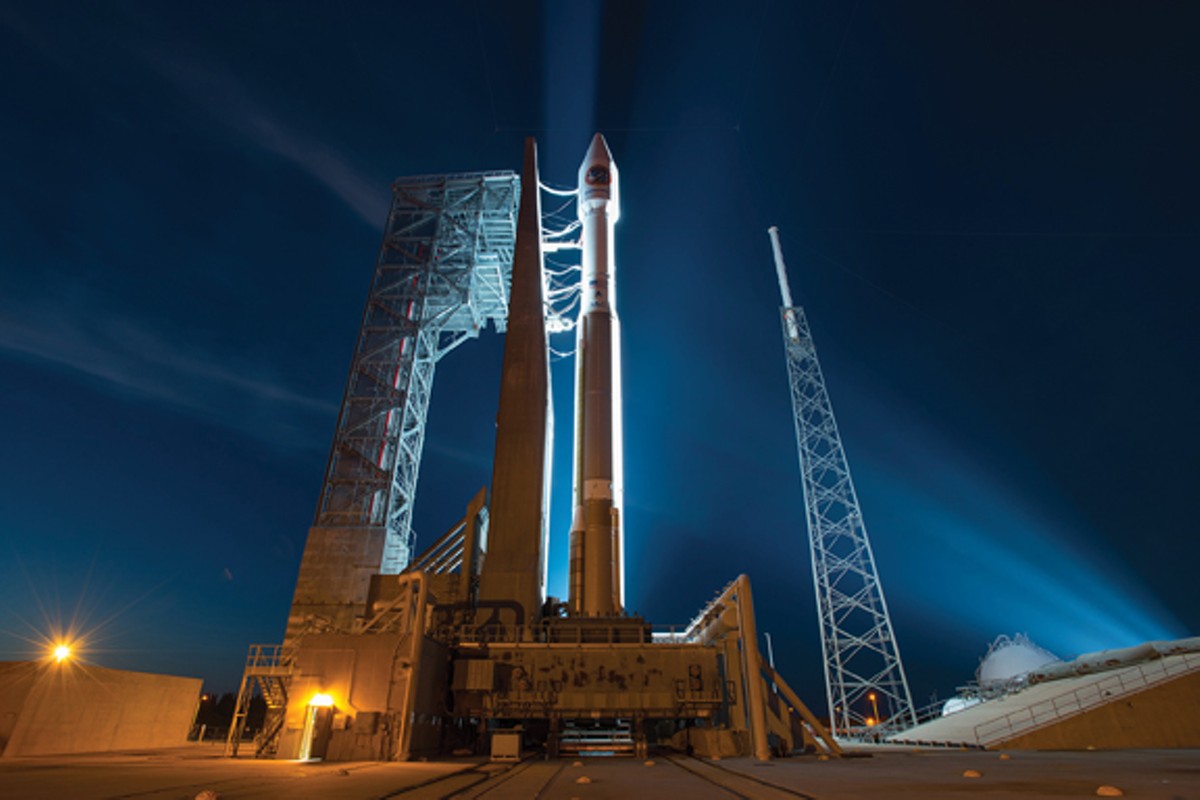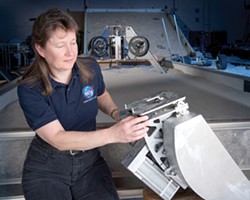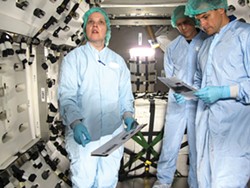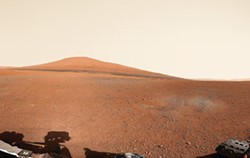Diane Linne was rototilling her garden in a leafy suburb of Northeast Ohio when she figured out how to generate rocket fuel on Mars. She had done this many times before — the gardening, that is — but as she watched the machine bring darker soil to the surface, supplanting dry dirt and distributing nutrients across a small patch of land, she found an answer to a question. It was so simple: Whether nurturing geraniums or propelling rockets, everything we need is all around us.
"I took that for a run and said, 'Oh, if this is a way of turning up moist soil, then it may work on Mars if I want to capture the water,'" she says in a quiet basement laboratory at NASA Glenn Research Center, that quiet campus on Brookpark Road that backdrops the morning commute for thousands in Northeast Ohio. "Why can't we rototill the Mars soil?"
It's a good question, one that reminds both advanced NASA scientists and casual telescope hobbyists that Mars isn't so different from Earth. The gap between the two planets is shrinking, thanks to people like Linne: She's a senior research engineer at Glenn, and her revelation is one of many that are thrusting the U.S. toward its next great space endeavor. "We have set a clear goal vital to the next chapter of America's story in space: sending humans to Mars by the 2030s and returning them safely to Earth, with the ultimate ambition to one day remain there for an extended time," former President Barack Obama wrote in an essay last fall.
This is NASA's most enterprising step into the final frontier since the Apollo program of the 1960s. It's a three-tier process that begins with research here on Earth and at the International Space Station, expands into the cosmos by utilizing lunar and Martian orbit and, eventually, delivers us to the fourth planet from the sun.
The journey is no one-tank trip. We're talking about a six-month ride in the revolutionary Orion spacecraft — named, of course, for the constellation that's guided voyagers for millennia — and that's just to arrive at the red planet. The crew of four to six astronauts would then stay on Mars for about 18 months or so, tilling the soil and waiting for the planet's orbit to line up again with Earth, before another six-month cruise across a 50-million-mile stretch of solar system freeway. It's a 30-month moonshot of moonshots daring not just in distance but time: The longest continual stretch any human has spent in space so far was 438 days, achieved by Russian cosmonaut Valeri Polyakov in the mid-90s.
The plan is for NASA's first run to lay the groundwork for many more. Science is an incremental thing. Likewise, the answer to one big question (getting to Mars) is really the answer to a million smaller questions. How much stuff should they bring? How much stuff could they bring? What sort of zero-gravity exercise is needed? What if a fire breaks out in the crew capsule? How will the vibrations of space travel affect the equipment onboard, and what can we do to mitigate that? What if the astronauts get really, really bored over those two and a half years?
"Certainly we are always looking for new areas of inspiration, and that inspiration can come from a lot of different places," Linne says, describing the small steps that occur in places like NASA Glenn. Inspiration can come from a garden. Or thinking about your car's solid oxide fuel cell technology and how it might harness oxygen on Mars. At NASA's sprawling Brookpark Road facility (first opened in 1942), and at many other research facilities around the U.S., like the Plum Brook Station near Sandusky, engineers are tackling the nitty-gritty questions posed by mankind's greatest road trip.
After decades of experience on the edge of human innovation, NASA knows a thing or two about risk management. You send a few humans to a strange new world millions of miles away, you're going to have to deal with a little human error. That's why Linne's on the job, along with thousands of other engineers and scientists across the NASA matrix. (Glenn alone employs more than 3,000 people, through direct staffing or contracts.) There's a lot riding on this one, not least of which is the astronaut's lives, but also billions of dollars and decades of planning.
"You don't want to send people there and say, 'If you don't do all these things right in the first three days, your mission's scrubbed,'" Linne says. "That would be too much risk."
***
Earthlings have long been fascinated by the red planet. In the 1870s, Italian astronomer Giovanni Schiaparelli published detailed Martian maps featuring expansive seas and an intricate network of canals, setting the stage for 150 years of obsession over the presence of water on the surface of Mars. Wernher von Braun published Das Marsprojekt in 1952 ("The Mars Project") and argued that landing humans on Mars was logistically feasible; we could haul our equipment to the planet piecemeal, over the course of thousands of trips, and erect habitats.
First, humans needed to launch themselves into Earth's orbit (Yuri Gagarin on April 12, 1961), then land on the moon (Neil Armstrong, Edwin "Buzz" Aldrin and Michael Collins via Apollo 11 on July 20, 1969), bringing the future into the present one mission at a time.
What's been known all along is that a lengthy project like the trip to Mars was going to require lots of water. If we could find some at our destination, then suddenly this whole thing becomes much more doable. By all accounts, we're in luck.
In 2003, NASA sent two exploratory rovers to the red planet: Opportunity remains active; Spirit got stuck in some dirt in 2009. (Both projects, it should be noted with awe and wonder at NASA's abilities, were only meant to collect data for 90 days.) Then, in 2012, NASA landed the plucky Curiosity on the surface, exponentially expanding our understanding of the planet. In the meantime, NASA also sent two probes into Martian orbit to gather a wealth of atmospheric data and images. Data from Curiosity and the probes gave hope in fits and streaks: There was evidence of water on Mars in glaciers and in hydrated minerals.
The fall of 2015 was a bigger watershed moment, if you'll pardon the wordplay: The Mars Reconnaissance Orbiter confirmed a pattern of ebbing and flowing "dark streaks" carved into the slopes of the planet's surface. "This is a significant development," John Grunsfeld, associate administrator of NASA's Science Mission Directorate in Washington, said at the time, "as it appears to confirm that water — albeit briny — is flowing today on the surface of Mars." (That same week, The Martian opened at the box office to nearly universal acclaim.)
"Back in the '70s and '80s and even '90s, Mars was very dry," Linne says. "Or so we thought."
Prior to the marquee manned mission, the next, most visible and important leg of the journey begins with the launch of the Mars 2020 Rover in three years — an even more sophisticated surface vehicle that will more comprehensively analyze and characterize the Martian surface and dramatic climate on which humans will have to survive for 18 months. Temperatures hover around 80 degrees below zero F in a carbon dioxide-rich atmosphere, with days ("sols") that last an extra 40 minutes compared to our good ol' 24-hour rotations. The gravity is low-key, compared to ours, and astronauts will have but a slight spring in their step as they walk across the windswept red soil.
On this December afternoon on Earth, NASA Glenn is a comparatively cozy 36 degrees beneath gray skies split now and then by a descending airplane. The complex seems shopworn, a patchwork of unremarkable suburban federal office buildings belying the cutting-edge advancements inside. Take the office of Joe Roche, with its three SLS rocket models standing at attention and insinuating the grand ambitions of science. Roche is working on the Universal Stage Adapter, which will connect this new breed of heavy-lift rocket, more powerful than any other rocket ever built, to the Orion spacecraft. "We're all really excited to be doing this," he says, much in the way one might describe restoring a fleet of '63 Corvettes.
The Orion spacecraft is the next generation of NASA innovation, the $1.3-billion souped-up coupe, if you like, that will get humans to Mars and quite literally change the trajectory of history. (NASA's 2017 budget as a whole clocks in at a cool $19.3 billion, with a notable and unanticipated $1-billion increase for the agency's exploration programs, which include the Orion and the SLS rocket.) But the spacecraft is just one thing, itself made of thousands of other things, incremental trial-and-error homework.
"You don't just say you're going to Mars, light a rocket and you're there," Roche says.
***
In a gray laboratory in the basement of one of the 150 buildings at Glenn spread across 350 acres, Linne and her team are hard at work on their rototilling project. This is a major key to keeping humans alive on Mars and getting them back home: In the Martian soil, astronauts will cultivate the oxygen they need to breathe, the water they need to drink and the fuel compounds they need to power up the vehicle.
It wasn't long after NASA's announcement about the briny, flowing water on Mars that Linne struck gold. Surface glaciers abound on the red planet, but they're farther below the surface than what's ideal for our future crew to mine. It's much easier to bring, for instance, a rototiller than an onshore drilling rig on your first journey to Mars.
NASA's rototiller is an ingenious but straightforward piece of machinery. In the basement lab, tanks of carbon dioxide, argon and nitrogen rest against the wall, ready to pipe a manufactured Martian atmosphere into a box that Linne will place over the tilling apparatus.
The tiller brings up simulated Martian soil, which is blown gently by a tiny muffin fan onto a copper incline. (Even through the Martian atmosphere is dramatically thinner than Earth's, you can still catch a nice breeze most days.) The soil then slides downward toward a mechanism where hydrated minerals can be separated and condensed — or maintained for drinking water and growing potatoes.
Generally speaking, 75 to 80 percent of rocket propellant is oxygen; the rest is methane. You split your H2O into its fundamental elements, and you've got most of your fuel and your breathing oxygen right there.
The leftover covalent hydrogen atoms can then be mixed with CO2 in the Martian air, which is 95-percent carbon dioxide. Four hydrogen atoms bind to one carbon atom to form methane — the other primary ingredient in rocket propellant. This is called the Sabatier Reaction, named for French chemist Paul Sabatier. He discovered the process in the 1910s, blissfully unaware that a century later, it would be among the most critical tools in mankind's future extraplanetary settlement.
This whole idea is known as "in-situ resource utilization," which means trying to use the stuff in your surroundings to help your exploration. It's not unlike early American pioneers' Westward journey. They weren't loading up their wagons with hay for their mules; they were relying on the presence of nutritious grasslands along the route.
"If they had to load up their wagon with all the hay that the mules needed to eat, all the water they needed to drink and tanks of oxygen for air for them to breathe, everyone would have died before they got to the Appalachian Mountains," Linne says. "But they didn't do that, right? They used in-situ resource utilization. The mules ate the grass on the side of the road, everybody drank the water and we have the air to breathe. So the pioneers did this a long, long time ago. They just didn't give it a fancy name."
Down the line, astronauts can also extract metals from the Martian soil and use them to create concrete or more complex equipment through 3-D manufacturing. The background in all these conversations is the possibility of one day building something on Mars, a permanent facility for experiments where astronauts might live and work. But for now, the primary concern is being able to build rocket fuel, not houses, because we want our astronauts to come home.
***
"Scene Magazine! That gives us instant cool points," Gail Perusek says. "We could use all of that."
Perusek works in the Zero-Gravity Research Facility at NASA Glenn which, by any account, is eminently cooler than your humble alt-weekly. Perusek is the project manager at the Human Research Program here, which, among other things, means she's studying how astronauts will stay healthy for their long, arduous and wholly unique 30-month trip to Mars.
In the middle of the room, a vertical treadmill commands attention. (Perusek has named the T2 treadmill "Colbert," as in Stephen.) A fairly involved network of bungees and harnesses hangs around machine; once safely strapped in, men and women run upwards, with the harnesses simulating zero gravity.
Perusek calls it "exploration exercise," and it's already in use up at the International Space Station. NASA has long studied the physical effects of living and working in space for varying durations. American astronaut Scott Kelly spent 340 days in space between 2015 and 2016, getting close to Polyakov's record. (Kelly, it should be noted, is a twin. NASA will compare his body to his brother Mark's, the control variable, to further pinpoint the effects of space on humans.) Astronauts on the Mars mission will eclipse the 340-day mark by about three times, and that's if everything goes well.
Leg muscles start atrophying first, without the grounding of gravity to keep them in working condition once you leave Earth's atmosphere. Exercise is an absolute necessity in that environment, not a New Year resolution to half-heartedly adopt and scrap by Groundhog Day. If you don't stay on top of it, your body will expire; so you must and you do, but even then, your life won't be the same once you get back home. ("I have the feeling that there is some kind of evil giant trying to press me into the ground," astronaut Samantha Cristoforetti told a Telegraph reporter in 2015 after being in space for 200 days. "Every time I take a step and have to lift the full weight of my leg, it feels like lifting a tree trunk.")
As prep, astronauts climb aboard planes to simulate the sensation of being in zero gravity. The plane pitches upward, then drops sharply into a 25-second freefall. Video footage of these experiments is trippy; the strapped-in subject uses resistance weights during the freefall, while other people sort of float around him or her and then crash to the floor abruptly.
Perusek's work doesn't stop in low Earth orbit or pre-mission; NASA teams continue to collect physical and psychological data on astronauts long after their return from space. The effects of zero gravity sojourns — and of living on Mars, half the mass of Earth and exerting one-third of its gravity — especially at increasingly longer intervals, are imposing.
The christening voyage to Mars includes the same concerns about astronaut health but with slightly more dramatic questions. More miles and more time mean more stuff. While Linne's in-situ team puts a dent in those needs (by cutting back on the oxygen tanks), Orion's limited crew space will still need to hold more equipment than previous trips and in a smaller space. For comparison sake, the International Space Station boasts more than 4,000 pounds and about 850 cubic feet of gear. Orion, on the other hand, will only provide 316 cubic feet of space to work with.
That question led to the creation of a device called ROCKY, "an ultra-compact, lightweight exercise device" that Perusek demonstrates in video footage. It looks sort of like your standard rowing machine but it accomplishes a wide variety of resistance exercises, running the gamut of muscle groups for the arduous physical toll looming ahead of the astronauts. Even then, storing the device is just one part of the puzzle. Designing it and the enclosed interior to allow astronauts to actually use it is another.
"It seems simple, fitting so much into a specific space," Perusek says. "But when you get into different crew member statures, different exercise styles, different modes of exercise, it's an interesting problem."
***
Elsewhere in the 51-year-old zero-gravity building, Dave Urban is working on Saffire, NASA's spacecraft fire experiment.
As Perusek's team works on how to keep humans healthy, Urban's team works to ensure that equipment will function properly and not, you know, fall apart in transit. But as with Colbert and the airplane freefalls, Urban and the rest of NASA need to get creative if they want to simulate extraterrestrial conditions.
This comes up a lot with the International Space Station, which is sort of a scientific rest area on the highway to Mars. There, astronauts deal with complete zero-gravity as the station tumbles around Earth at 17,000 miles per hour.
The ISS first launched into orbit in 1998, and it's been a key link between the leaps of Apollo 11 and upcoming missions. There, researchers can simulate conditions that astronauts will encounter en route to the moon or to Mars.
In trying to understand how fires might break out and be suppressed in space, Urban and his team will work in coordination with trips up to the ISS. (Saffire-I will travel to the ISS on March 17 aboard the Cygnus spacecraft. Saffire-II will embark in June. Six total experiments are planned.) A sample card of cotton and fiberglass fabric — 0.5 meters by 1 meter — will be loaded into a spacecraft traveling up to the station. There, the crew will take out all the supplies, fill it up with trash and the experiment materials and then thrust it back into Earth's atmosphere. At that point, NASA ignites a fire. "This is to learn about how a real thing would burn in a spacecraft environment on the way to Mars," Urban says.
Aside from the in-depth ISS excursions as part of Saffire, the team runs other zero-gravity projects in their own vacuum chamber, an intimidating-looking 432-foot drop tower ensconced in metal.
Here's how it works: A 2,500-pound experiment carrier holds the Saffire project equipment; the vacuum chamber allows enough room to get a dose of zero-g conditions. ("It's kind of like dropping a mini Cooper automobile and letting it free fall 432 feet," says Gary Ruff, Saffire project manager.) The carrier drops down the chamber and lands in a padded surface, like dropping a bowling ball into a box full of packing peanuts.
Experiments in the drop tower investigate how various things might interact in space — liquids and gases, pieces of equipment and flames.
"A spacecraft fire is one of the greatest crew safety concerns for NASA and the international space exploration community," Ruff says.
"Saffire seeks to answer two questions," says David Urban, principal investigator. "Will an upward spreading flame continue to grow or will microgravity limit the size? Secondly, what fabrics and materials will catch fire and how will they burn?"
It's a multifaceted and complex effort; the team looks at fire prevention, detection, suppression and cleanup, all couched in the parameters of an enclosed 316-cubic-square-foot thimble floating in space with limited storage and unlimited potential for disaster. And zero escape.
The world should rest assured that Cleveland's best are on the beat.
***
More than 100 years ago, there was what historians now call "canal furor" after the Mars map first designed by Giovanni Schiaparelli prompted a brief flurry of excitement in the astronomical scene. Humans have been amazed and intrigued ever since.
John Noble Wilford was a reporter for The New York Times when he covered the Apollo 11 moon landing in 1969. Like the scientists, engineers and astronauts he wrote about, Wilford never stopped thinking about our shared interest in the next giant leap.
"Mars tugs at the human imagination like no other planet," he wrote later. "With a force mightier than gravity, it attracts the eye to the shimmering red presence in the clear night sky."
The Martian, directed by Ridley Scott and starring Matt Damon, sort of crystallized that collective thrill when it hit theaters last year. Engineers at NASA Glenn mentioned the movie during nearly every interview conducted with Scene, and by and large they enjoyed the pop culture sensation that came with it and nodded with a degree of approval as to how the film depicted most of the scientific aspects of the project, particularly the crew's trip there and the whole potato farming thing. It wasn't as antithetical as 2000's Mission to Mars, for instance.
It won't be too much longer before we don't have to rely on Hollywood's portrayal of a visit to Mars, though.
The next exploratory SLS mission (called EM-1 in shorthand), sort of an "all-but-manned Orion," will fly out in 2018 and spin through lunar orbit for a bit. Then, among an array of other checkpoints, comes the 2020 Mars Rover, in rather quick succession. As long as the federal government maintains or increases its funding and interest in space exploration and science, as Obama noted in his essay last fall, we'll soon watch the fruits of their labor on television (or virtual-reality headsets). The last time that happened, we watched a man walk on the moon. And the last man to do so, Gene Cernan, who passed away this month, said upon the last trip there in 1972, "As I take these last steps from the surface for some time into the future to come, I'd just like to record that America's challenge of today has forged man's destiny of tomorrow."
Tomorrow is coming.
"Mars was always 40 years away, or 30 years away," former NASA administrator Maj. Gen. Charles Bolden said recently. "But today, it's closer than ever before."
Note: An earlier version of this story misspelled French chemist Paul Sabatier's name.















